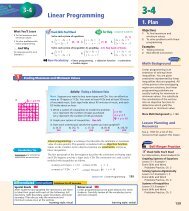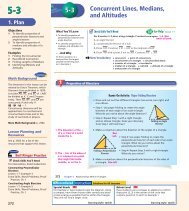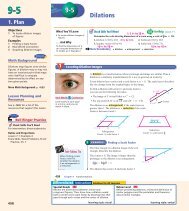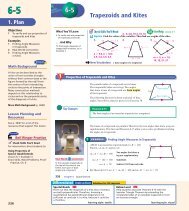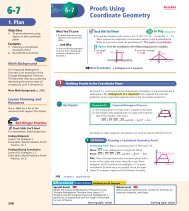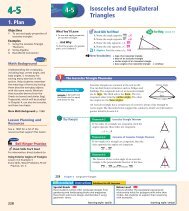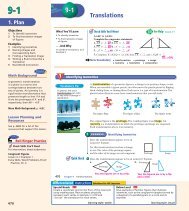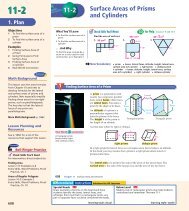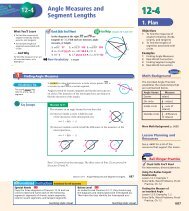Parenting - Finneytown Local School District
Parenting - Finneytown Local School District
Parenting - Finneytown Local School District
Create successful ePaper yourself
Turn your PDF publications into a flip-book with our unique Google optimized e-Paper software.
PHP <strong>Parenting</strong> Perfectionists<br />
<strong>Parenting</strong><br />
Perfectionists<br />
Encouraging Healthy Risk-Taking for Risk Evaders<br />
By Dr. Hope E. Wilson & Dr. Jill L. Adelson<br />
13 • <strong>Parenting</strong> for High Potential
Jana received a flier for an art program for children<br />
in the community. Excitedly, she showed her gifted<br />
elementary-aged daughter, Calla, the paper, and<br />
waited expectantly for shouts of excitement about the<br />
opportunity. Instead, she was met with a shrug of the<br />
shoulders and an indifferent look. Calla told her that<br />
art was not her “thing” and that she did not want to<br />
go to art camp. Perplexed, Jana stared at her child,<br />
not understanding why she wasn’t interested.<br />
Now, if this was the first camp that Calla had<br />
rejected for the summer, Jana might have just<br />
dismissed this as a lack of interest in art. However,<br />
Calla had systematically rejected soccer camp,<br />
theater camp, softball camp, music camp, and dance<br />
classes. It was beginning to look like she would be<br />
spending all day, every day, of the summer at home<br />
in her room.<br />
Parents of gifted children like Calla are often<br />
baffled by their children’s dismissal of many extracurricular<br />
opportunities. It is hard to understand<br />
why children with such talent and potential would<br />
not be excited about joining and participating in a<br />
variety of activities that would showcase their skills.<br />
Parents often come to us asking about their child’s<br />
reluctance and wondering how they can encourage<br />
their child to develop his or her talent when their<br />
child avoids taking risks.<br />
In actuality, risk avoidance is characteristic<br />
of perfectionistic behaviors. We often call these<br />
children “Risk Evaders” (Adelson, 2007; Adelson<br />
& Wilson, 2009). Risk Evaders tend to avoid trying<br />
new things or participating in competitions or<br />
even activities in which they believe they may not<br />
perform perfectly. By avoiding these activities, Risk<br />
Evaders often miss out on excellent opportunities<br />
for further development of talent, self-esteem, and<br />
confidence in their abilities. As parents, the underlying<br />
motivation for avoiding these activities and<br />
how to help your child extend his or her participation<br />
is difficult to understand.<br />
Perfectionistic Behaviors<br />
Rather than classify children as perfectionists,<br />
we prefer to discuss behaviors that tend to relate to<br />
perfectionistic tendencies. Thus, we can focus on<br />
changing behaviors, rather than labeling children,<br />
which can have negative consequences. Perfectionistic<br />
behaviors are associated with a focus on achieving<br />
high goals. These behaviors may be negative (i.e.,<br />
unhealthy) or positive (i.e., healthy). As parents and<br />
caregivers for gifted children, our goal is to help children<br />
move from using perfectionism in an unhealthy<br />
way to exhibiting healthy behaviors that continue to<br />
address their need to achieve high goals.<br />
Healthy perfectionism leads children to strive<br />
for excellence, set high (yet manageable) goals, and<br />
pursue their areas of talent. Unhealthy perfection-<br />
<strong>Parenting</strong> Perfectionists PHP<br />
ism, on the other hand, prevents children from managing<br />
their time effectively, immobilizes them from pursing<br />
areas of talent, or otherwise interferes with their happiness<br />
or well-being. Table 1 illustrates some of the differences<br />
between healthy and unhealthy perfectionism.<br />
Table 1<br />
Healthy and Unhealthy Perfectionistic Behaviors<br />
Healthy Perfectionistic Behaviors<br />
Sets high, realistic goals<br />
Enjoys challenges<br />
Has confidence in abilities<br />
Accepts defeats<br />
Learns from mistakes<br />
Exercises good time management skills<br />
Unhealthy Perfectionistic Behaviors<br />
Unrealistically expects perfection<br />
Avoids challenges<br />
Lacks confidence and self-esteem<br />
Is a poor loser<br />
Is devastated by mistakes<br />
Lacks time-management skills<br />
When children begin to exhibit behaviors that illustrate<br />
unhealthy perfectionism, parents, teachers, and<br />
caregivers must work together to help them develop<br />
healthier habits. Healthy perfectionism can allow gifted<br />
and talented children to have highly successful and<br />
enriching lives.<br />
Risk Evaders<br />
As noted above, Risk Evaders are children who<br />
exhibit unhealthy perfectionistic behaviors that tend to<br />
prevent them from participating in activities that have<br />
the possibility for failure, such as Calla who refused to<br />
attend art camp. Other Risk Evaders may not audition for<br />
school plays, try out for sports teams, or join in extracurricular<br />
activities. Competition is particularly an issue for<br />
these children, as they fear revealing imperfections. These<br />
behaviors may also manifest themselves in academic<br />
settings as students who “forget” to complete assignments<br />
or seldom volunteer answers in class discussions. Table 2<br />
outlines some characteristics of Risk Evaders.<br />
Table 2<br />
Characteristics of Risk Evaders<br />
Avoid challenges<br />
Miss school assignments<br />
Lack of participation in school activities<br />
and competitive situations<br />
Hide perceived imperfections<br />
Focus on outcomes<br />
Narrow focus of interests<br />
September 2010 • 14
development into well-rounded citizens. These behaviors<br />
may even carry over to children avoiding activities<br />
such as a family game that a sibling is better at, or that<br />
the child does not think he or she is likely, or even<br />
guaranteed, to win.<br />
Through their reluctance to participate in a variety<br />
of activities, children miss out on opportunities to<br />
develop skills and interests in a variety of areas. This<br />
diversity of activities helps to develop well-roundedness.<br />
By trying many new things, children can discover new<br />
interests and learn how to cope with mistakes and imperfections.<br />
They can learn how to enjoy participation<br />
without the pressure of a perfect or faultless performance.<br />
A talented pianist may enjoy playing soccer,<br />
even if she isn’t the star player. A gifted writer may<br />
enjoy time spent participating in a community theater<br />
production. The key is being willing to try a variety of<br />
activities and risk not being the best but instead focusing<br />
on the joy of the activity itself.<br />
Competition and Risk-Taking<br />
One way to encourage participation and joy of the<br />
discipline is to find activities that avoid competition<br />
between participants. For Risk Evaders who are reluctant<br />
to engage in situations in which they may not be<br />
as good as other children, cooperative or noncompetitive<br />
situations may be more successful starting points.<br />
A child may be more willing to create art as part of an<br />
afterschool enrichment class than for a national art<br />
competition. Similarly, many community and recreation<br />
centers offer art, dance, gymnastics, or swimming classes<br />
for children who are more focused on exposure to a new<br />
<strong>Parenting</strong> name of Perfectionists column or articlePHP PHP<br />
area and enjoyment than serious competition. These are<br />
excellent ways for children to try out new areas of interest<br />
without pressure for outstanding performance.<br />
That being said, as a child begins to develop elite<br />
or advanced talent in a specific area, higher levels of<br />
competition may be necessary to fully develop his or her<br />
talent. Auditions or portfolios may be required to attend<br />
top schools or gain access to elite trainers or programs.<br />
Children who shy away from these experiences may miss<br />
out on opportunities to develop their talent. To develop<br />
elite status, children may need to engage in competitive<br />
activities. Competition will also allow children to hone<br />
their own skills in response to others’ advanced abilities<br />
and will allow them to receive feedback on where they<br />
are in developing and exhibiting their skills. Parents<br />
can help their children in these instances by focusing<br />
on enjoyment of the activity and striving to outperform<br />
their personal performances rather than other children’s<br />
performances. For example, the goal should be to score<br />
more goals than the last game, rather than beat the opposing<br />
team.<br />
Developing Healthy Risk-Taking<br />
The goal of parents of Risk Evaders is to help children<br />
move from unhealthy perfectionism to healthy<br />
risk-taking. To encourage children to begin taking risks<br />
in activities in which they may fail, make a mistake, or<br />
their faults may be shown, parents are often in need of<br />
advice. Children who are reluctant to participate in activities<br />
due to unhealthy perfectionism need a supportive<br />
and safe environment, concrete and specific praise,<br />
and low-risk starting points.<br />
September 2010 • 16
Table 3<br />
PHP <strong>Parenting</strong> Perfectionists<br />
Types of Praise<br />
Empty Praise<br />
“You are a good dancer.”<br />
“You are so smart.”<br />
“Great job.”<br />
“You beat the Cardinals.”<br />
“You are so creative.”<br />
Safe Environments<br />
Parents can create safe and supportive environments<br />
within their families to encourage healthy risk-taking.<br />
By acknowledging your own mistakes, you can work<br />
to create a place in which honesty, rather than perfection,<br />
is valued. Recently, one of the authors forgot a<br />
deadline at work. As she relayed the story at the dinner<br />
table, her family was able to see not only that she made<br />
a mistake but also how she coped with it by discussing<br />
the issue with her boss. This opened up to a further<br />
discussion over dessert about how she was frustrated<br />
with herself for the mistake but how she could overcome<br />
and continue and that it would not prevent her from<br />
volunteering for other projects in the future. Her family<br />
talked and shared about how they all felt when they are<br />
disappointed in themselves and how they coped. Communication<br />
is the key to creating a safe environment for<br />
children within a family.<br />
Concrete and Specific Praise<br />
Another way to build a safe and secure environment<br />
and raise a child’s confidence level is to provide concrete<br />
and specific praise. Empty praise or continual praise that<br />
is not linked to specific actions does little to help a child<br />
develop a sense of accomplishment or pride in his or her<br />
abilities. It is possible to provide your child unconditional<br />
and continual love and support, while communicating<br />
praise at specific actions. When parents consistently find<br />
concrete actions and accomplishments to encourage in<br />
their children, the children learn to find joy in their successes,<br />
as well. For example, “I am so proud of how hard<br />
you worked on that pirouette” is more meaningful to a<br />
child than, “You are such a good dancer.” See Table 3 for<br />
more examples of specific praise.<br />
3 • 17 <strong>Parenting</strong> • <strong>Parenting</strong> for High for Potential High Potential<br />
Concrete Praise<br />
“I love how hard you worked on<br />
getting that pirouette right.”<br />
“You learned so much this week<br />
about your history project.”<br />
“Excellent job scoring that goal<br />
during the game today! I can tell you<br />
practiced so hard.”<br />
“You made more baskets than you<br />
did last week.”<br />
“I love your idea for the art project—<br />
it is so unique. You have great ideas.”<br />
These types of praise help children appreciate their<br />
individual successes and will help to fortify their selfconcepts<br />
to withstand disappointments that come from<br />
occasional failures.<br />
Low-Risk Starting Points<br />
For children who are extreme Risk Evaders, it can<br />
be a struggle to entice participation in any new activity.<br />
Thus, parents may need to start on small scales and<br />
build on successes. A child who enjoys pick-up games of<br />
ball in the neighborhood may be encouraged to join the<br />
community t-ball league. A children’s church choir may<br />
be less intimidating for a shy, but talented, singer than<br />
a large school choir. Organizations such as Girl Scouts,<br />
Boy Scouts, Boys and Girls Clubs, YMCA, and 4H also<br />
provide opportunities for children to try a variety of<br />
activities in a noncompetitive environment. As children<br />
grow in skills and confidence, they can extend their<br />
activities to include more competitive environments.<br />
Suggestions for Parents<br />
Although these guidelines provide a general sense of<br />
direction, many parents wish for specific ideas for their<br />
Risk Evaders. These suggestions are meant to be activities<br />
that you could start as family traditions on a regular<br />
basis, or even as one-time experiences, tomorrow.<br />
Family Adventure Night<br />
One simple way to encourage healthy risk-taking is to<br />
institute “Family Adventure Night.” Family Adventure<br />
Night is a chance for families to cooperate and try new<br />
activities that are outside of their comfort zone. By modeling<br />
healthy risk-taking, parents show children that having<br />
fun is more important than avoiding mistakes. These<br />
adventure nights provide a place to develop a safe and<br />
secure environment for imperfections and also provide<br />
low-risk starting points for risk-taking. Family Adventure<br />
Nights might be athletic activities, such as miniature golf,<br />
bowling, or roller skating. They could also be impromptu<br />
activities at home, such as charades, karaoke, or learning<br />
a new dance. With slightly more preparation, families<br />
could work together on a new recipe, craft, or household<br />
project. The idea is to pick an activity that no one has<br />
a particular talent for but that everyone would consider<br />
enjoyable. This provides an opportunity to laugh at your<br />
own mistakes and enjoy participation rather than perfection<br />
or high performance. These activities also provide<br />
an opportunity for parents to be an example, sharing with<br />
their children any uneasiness about trying something new,<br />
excitement over improvements (rather than winning),<br />
and mistakes made.<br />
Family Game Nights<br />
Lots of family resources recommend family game<br />
nights to build community and facilitate communica-
tion. For Risk Evaders, family game nights have the<br />
additional benefit of providing opportunities to develop<br />
skills related to coping with competition and overcoming<br />
the fear of losing. Friendly competition on a board<br />
game can be a learning opportunity for children when<br />
parents purposefully guide discussion toward the way<br />
to cope with mistakes and talking through their own<br />
mistakes in the game. In addition, emphasis should be<br />
placed on effort, skills, and fun rather than the ultimate<br />
winner or loser of the game. Games such as Cranium<br />
provide opportunities to try skills in a variety of areas<br />
(such as drawing, solving word puzzles, trivia, music,<br />
and acting). Other games develop unique skills such as<br />
visual acuity (e.g., Pictureka), spelling and vocabulary<br />
(e.g., Bananagrams), logic (e.g., Set), flexibility (e.g.,<br />
Twister), or general silliness (e.g., Mad Gab). The key<br />
is to find games that the whole family will enjoy playing<br />
together, and parents can model appropriate responses<br />
to competitive outcomes.<br />
Story Sharing<br />
Story sharing is seeking out and identifying stories<br />
that illustrate healthy risk-taking and sharing them with<br />
your children. Library books, television shows, movies,<br />
and biographies can provide ample examples for<br />
discussion. Even audition shows for reality television<br />
can be used to discuss the bravery of contestants with an<br />
aspiring performer. Biographies of eminent personalities<br />
often show examples of times in which it was necessary<br />
to risk failure to pursue dreams. Posing questions during<br />
the story can enhance the discussion and guide children<br />
to develop an understanding for themselves. For<br />
example, asking the child what might have happened if<br />
Louis Pasteur had thrown away his “contaminated” agar<br />
plates rather than noticing the antibacterial properties<br />
of penicillin. In another situation, a child could<br />
consider how Helen Keller must have felt the first time<br />
she stepped onto stage to give a speech during her long<br />
career as a public speaker, knowing the obstacles that<br />
she would have to overcome.<br />
<strong>Parenting</strong> Perfectionists PHP<br />
Homework<br />
This article, so far, has focused on extracurricular<br />
activities and talents, but what about Risk Evaders and<br />
academic pursuits? Risk Evaders may avoid completing<br />
or attempting school assignments when they feel that<br />
they may not be able to do them perfectly. Rather than<br />
risk exposing their faults, the child may choose to “lose”<br />
assignments or “forget” to do them entirely. This often<br />
comes to a boiling point for families during homework<br />
time. To prevent confusion, parents can work to maintain<br />
clear lines of communication with the teacher. By<br />
working as a team, teachers and parents facilitate student<br />
success. Parent-teacher communications should be<br />
ongoing. Sometimes, children will display perfectionistic<br />
tendencies in one setting and not the other, so teachers<br />
and parents may not both realize that the child is<br />
exhibiting unhealthy perfectionistic behaviors. Whether<br />
the behaviors occur in one or both places, teachers and<br />
parents working together is the key. Parents concerned<br />
with the effects of risk-avoidance on homework and<br />
academic performance should schedule a meeting with<br />
the teacher. Ask the teacher about daily and weekly<br />
homework expectations and consider having your child<br />
use a planner to record assignments and for parents and<br />
teachers to communicate with one another.<br />
Because Risk Evaders are often focused on the outcome<br />
and whether they will be perfect, parents need to<br />
help them learn to appreciate the process and how they<br />
grow and improve during the process. This is particularly<br />
important when children are working on projects or<br />
studying for tests that cover an extended time in history.<br />
Rather than wait for the teacher to evaluate and grade<br />
the project or test, talk with your child about what she<br />
or he did well and what he or she will do differently next<br />
time. Also take the time to celebrate the completion of<br />
the project rather than waiting and celebrating a grade.<br />
When helping a Risk Evader move from avoiding<br />
assignments to doing them, you may notice that he<br />
or she wants reassurance with each step (or problem)
PHP <strong>Parenting</strong> Perfectionists<br />
Parents of Risk Evaders can<br />
work to create a safe and secure<br />
environment and provide<br />
specific praise and low-risk<br />
starting points for activities.<br />
that it was done perfectly. Avoid checking the entire<br />
assignment and talk with your child about the purpose<br />
of homework. Emphasize the importance of practice and<br />
of growing rather than on being perfect each time. Once<br />
the homework is returned, talk about whether the child<br />
has mastered the concept or needs more practice. Keep<br />
in mind that mastery is not the same as 100% correct.<br />
Final Thoughts<br />
One of the most frustrating situations is to parent a<br />
child who exhibits unhealthy perfectionistic behaviors.<br />
This article has detailed the specific characteristics of<br />
unhealthy and healthy perfectionism, specifically as they<br />
relate to Risk Evaders. Parents of Risk Evaders can work<br />
to create a safe and secure environment and provide<br />
specific praise and low-risk starting points for activities.<br />
Specifically, they can begin family traditions such as<br />
Family Adventure Night, game nights, or sharing stories.<br />
Homework can be an especially frustrating time for<br />
unhealthy perfectionists, but parents can help children<br />
by encouraging time management skills, maintaining<br />
clear communication with teachers, and celebrating and<br />
acknowledging the process rather than the outcome.<br />
Although Jana’s daughter was not interested in the<br />
art classes, eventually a solution was reached. After some<br />
advice, Jana decided to discuss the summer activities<br />
with Calla. She was, indeed, afraid of not being as good<br />
as the other children in the classes. After reassurance and<br />
talking through some scenarios, Calla carefully looked<br />
through the summer guide for the local recreation center.<br />
She was excited to learn they offered chess classes, and<br />
Calla enthusiastically joined the class, even though she<br />
(nor either of her parents) had ever played the game!<br />
19 • <strong>Parenting</strong> for High Potential<br />
Resources<br />
Community Organizations<br />
Girl Scouts of the USA<br />
http://www.girlscouts.org<br />
Boy Scouts of America<br />
http://www.scouting.org<br />
Boys & Girls Clubs<br />
of America<br />
http://www.bgca.org<br />
YMCA<br />
http://www.ymca.net<br />
4-H<br />
http://4-h.org<br />
Articles<br />
Adderholdt-Elliott, M. (1989). Perfectionism and underachievement.<br />
Gifted Child Today, 12(1), 19–21.<br />
Adelson, J. L. (2007). A “perfect” case study: Perfectionism<br />
in academically talented fourth graders. Gifted<br />
Child Today, 30(4), 14–20.<br />
Books<br />
Adelson, J. L., & Wilson, H. E. (2009). Letting go of<br />
perfect: Overcoming perfectionism in kids. Waco, TX:<br />
Prufrock Press.<br />
Greenspon, T. S. (2007). What do when good enough isn’t<br />
good enough. Minneapolis, MN: Free Spirit.<br />
Authors’ Note:<br />
Hope E. Wilson, Ph.D., is an assistant professor of<br />
elementary education at Stephen F. Austin State University<br />
in Nacogdoches, TX. She earned her doctorate in<br />
educational psychology with an emphasis in gifted education<br />
from the University of Connecticut. Prior to her<br />
career in academia, Hope was an elementary art teacher<br />
in Texas. She, along with her coauthor, wrote Letting Go<br />
of Perfect: Overcoming Perfectionism in Kids, a practical<br />
guide for parents and teachers to help children overcome<br />
unhealthy perfectionism.<br />
Jill L. Adelson, Ph.D., is an assistant professor at the<br />
University of Louisville. Dr. Adelson’s experiences with<br />
gifted children include teaching fourth grade self-contained<br />
gifted and talented classes and working in classes<br />
as a professional development staff member for Project<br />
M 3 : Mentoring Mathematical Minds. She provides professional<br />
development for educators across the country<br />
and presents at local, state, national, and international<br />
conferences, including NAGC and the World Council<br />
for Gifted and Talented Children. She and Hope E.<br />
Wilson coauthored Letting Go of Perfect: Overcoming<br />
Perfectionism in Kids (2009).



